If you love tamales but don’t have access to fresh masa from the grocery store, then this post is for you. All you need is a few simple ingredients to make the best masa for homemade tamales.
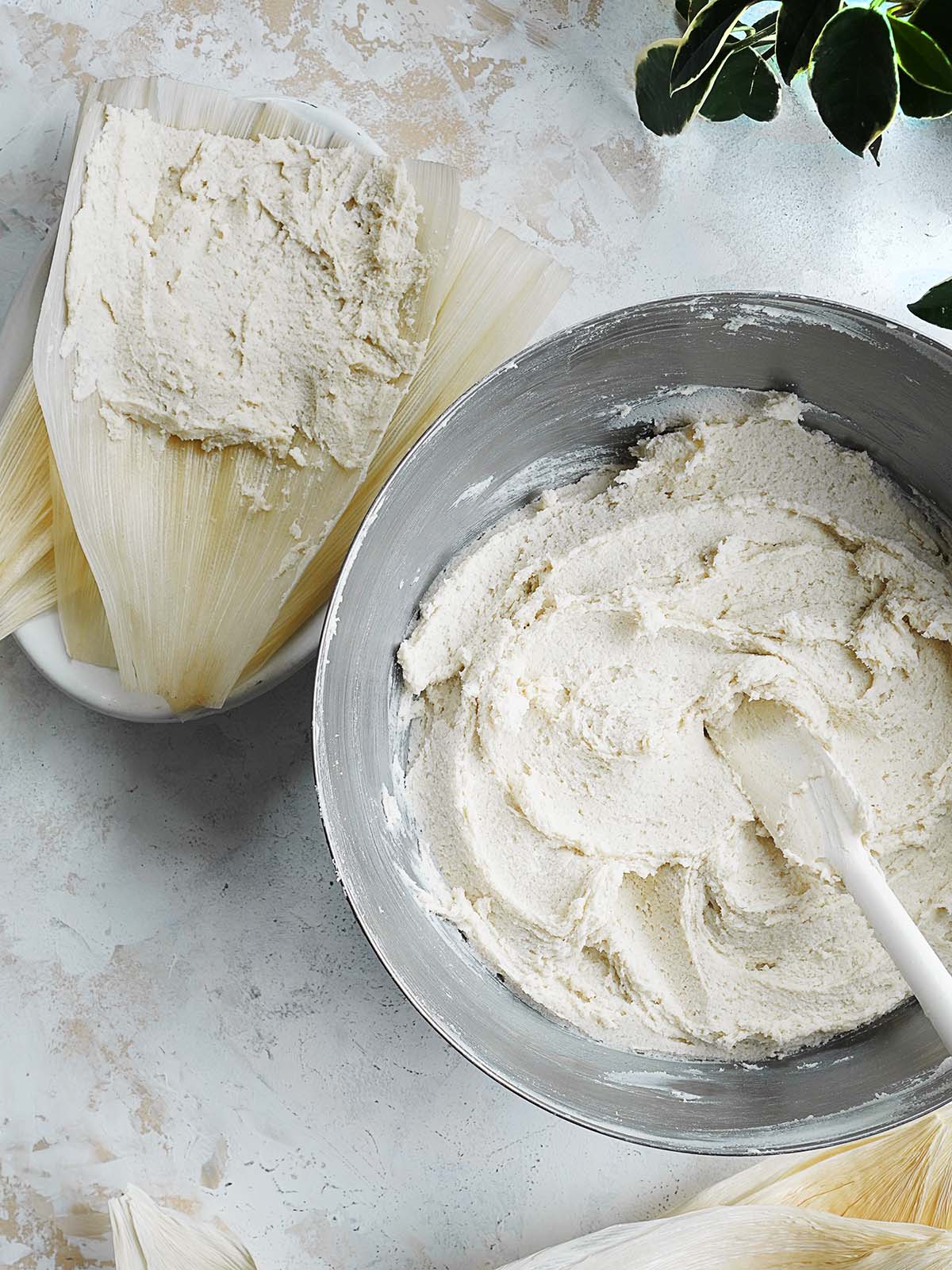
Tamales are all about a good and flavorful masa. Without a good masa for tamales, can make them turnout soggy, too hard or just plain bland.
In Mexico we make Tamales with with two different types of masa: 1) Prepared nixtamalized corn masa (found at latin stores) or 2) with masa harina, which is a specific corn flour like Maseca brand.

Masa Nixtamalizada Vs. Masa Harina
Nixtamalization is a Mexican tradition the way corn is prepared. The Aztecs and Mayans learned that if they boiled their corn with limestone or ash from the cooking fire, it changed its qualities for the better.
It resulted in softened kernels with enhanced aroma and flavor. Masa for tamales is typically coarser in texture and has a consistency that allows it to spread easily on the corn husks for wrapping the tamales. It might also include additional ingredients such as lard or other fats to enhance flavor and texture. When you find “masa for tamales” in a Latin grocery store, it is usually a specialized product designed to make the tamal-making process easier and more successful.
Masa harina is a type of flour made from dried hominy, which is corn that has been treated with an alkali. The alkali treatment, known as nixtamalization, involves soaking the corn in an alkaline solution, usually limewater, which helps remove the outer hull and germ of the corn. This process not only softens the corn but also improves its nutritional value by making certain nutrients more bioavailable.
After nixtamalization, the corn is washed, dried, and ground into a fine powder, resulting in masa harina.
Fresh masa is best but…
My number one option for making tamales will always be using fresh masa. However, if you can’t buy fresh masa, there’s still hope. In this post, I will show you how to make masa recipe using masa harina.
Why this recipe works
- This flour is a traditional ingredient in Mexican cuisine. It’s so versatile since it’s more available worldwide and has a longer shelf life that the fresh kind.
- It tastes delicious and it’s easy to make.
- Make as little or as much as you want!
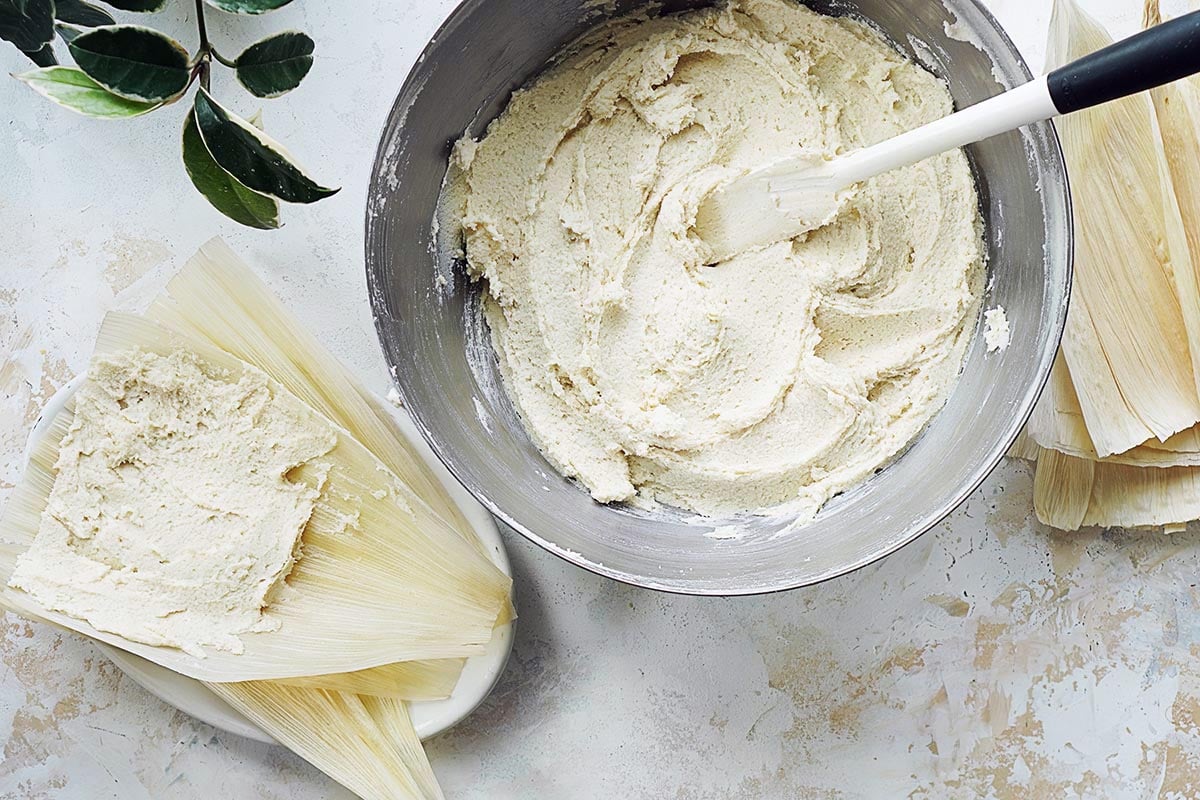
Masa Ingredients
Are you ready to make the best homemade masa ever? Here is what you will need to get started (it makes 3 lbs & 4 oz of masa):
- Masa Harina like Maseca. This is the most popular corn flour brand but there are others as well. Just look for one that says masa harina on the bag.
- Vegetable shortening or lard – at room temperature.
- Traditionally pork fat it’s used on tamales but vegetable shortening delivers the same consistency without the saturated fats.
- Don’t use oil. For best tamales you need a solid vegetable shortening or lard.
- Softened butter may also work as an alternative.
- Baking powder
- Table salt – for this recipe don’t use sea or kosher salt as we need a fine grain salt.
- Broth – Use beef, chicken broth or vegetable for vegetarian/vegan tamales . It should be at room temperature. It should not be hot since it will melt the shortening too fast and it won’t reach the perfect consistency.
***Find the complete recipe with measurements below.
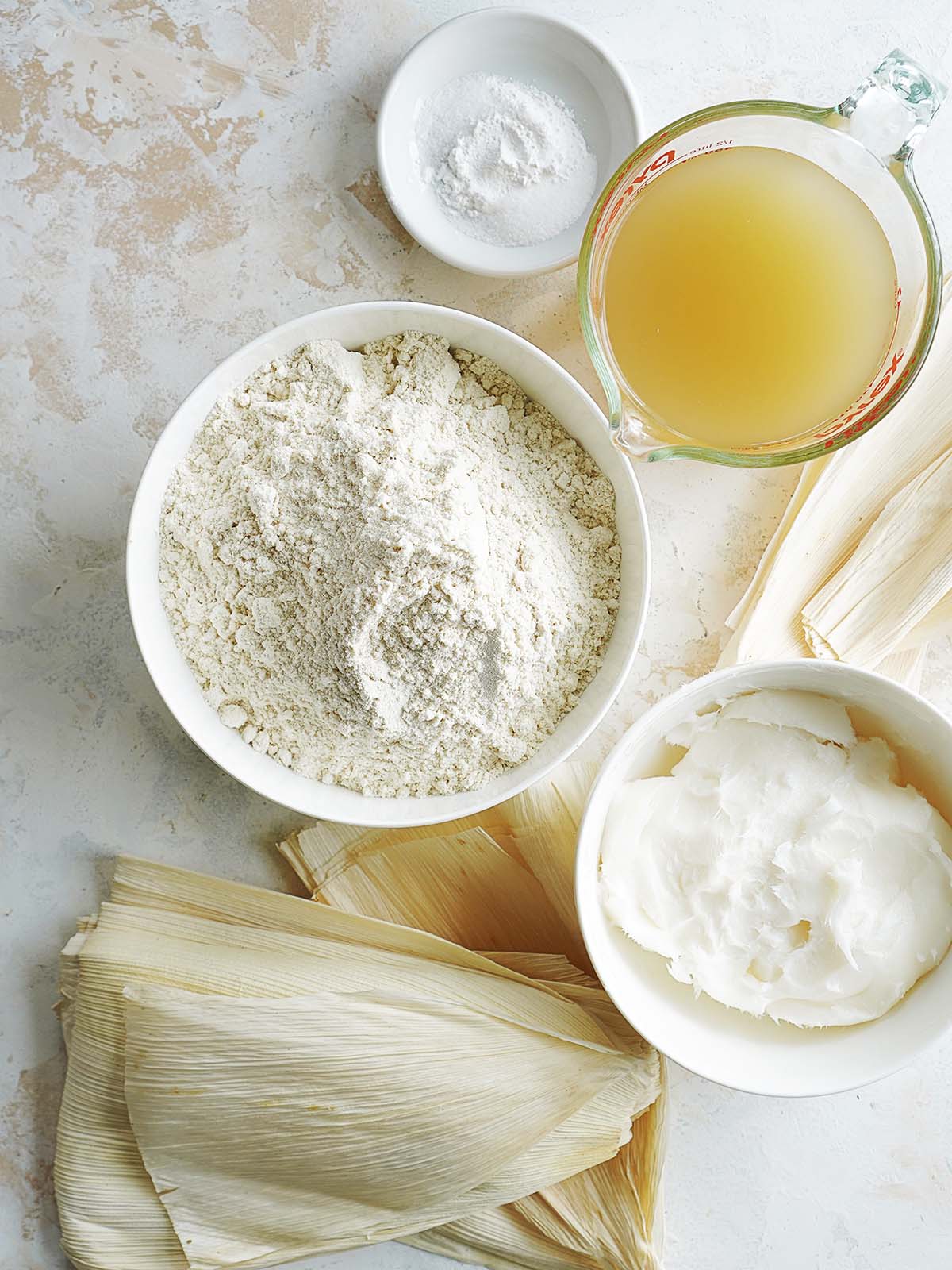
Masa harina is used to make corn tortillas, tlacoyos, these Tamales Verdes with Green Chile, Corn and Cheese and a variety of other Mexican dishes.
Want to make sweet tamales? This recipe for Tamales De Elote is made with fresh corns and are wrapped in fresh corn husks. Give them a try!
How to make masa for tamales
Let’s start by knead the shortening/lard
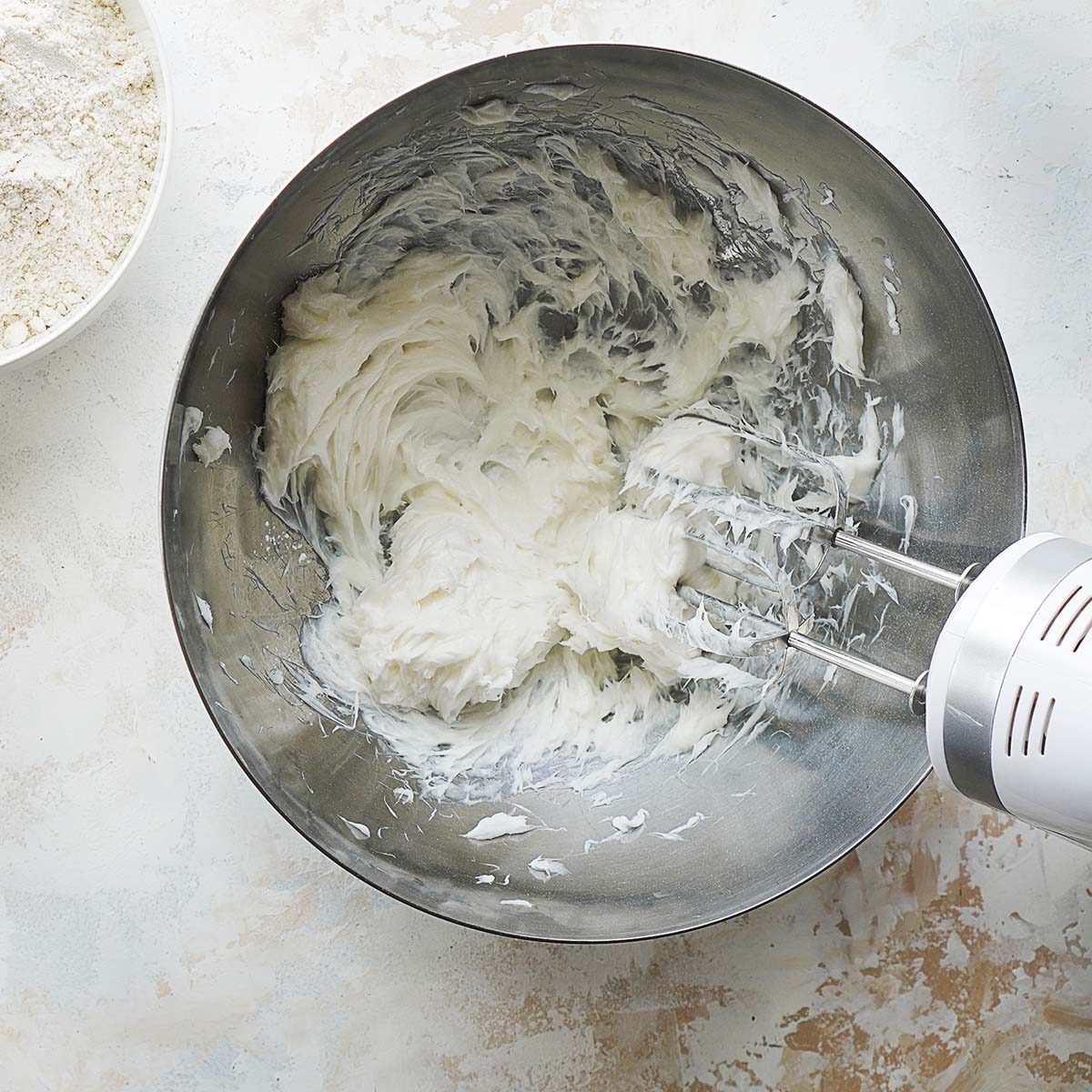
- In a large bowl, add the shortening/lard and knead with your hands, a hand mixer or a stand mixer.
If kneading by hand, the mixture will take about 15 to 20 minutes to reach the perfect texture and consistency. If kneading with a mixer, beat for 5 minutes on medium speed.
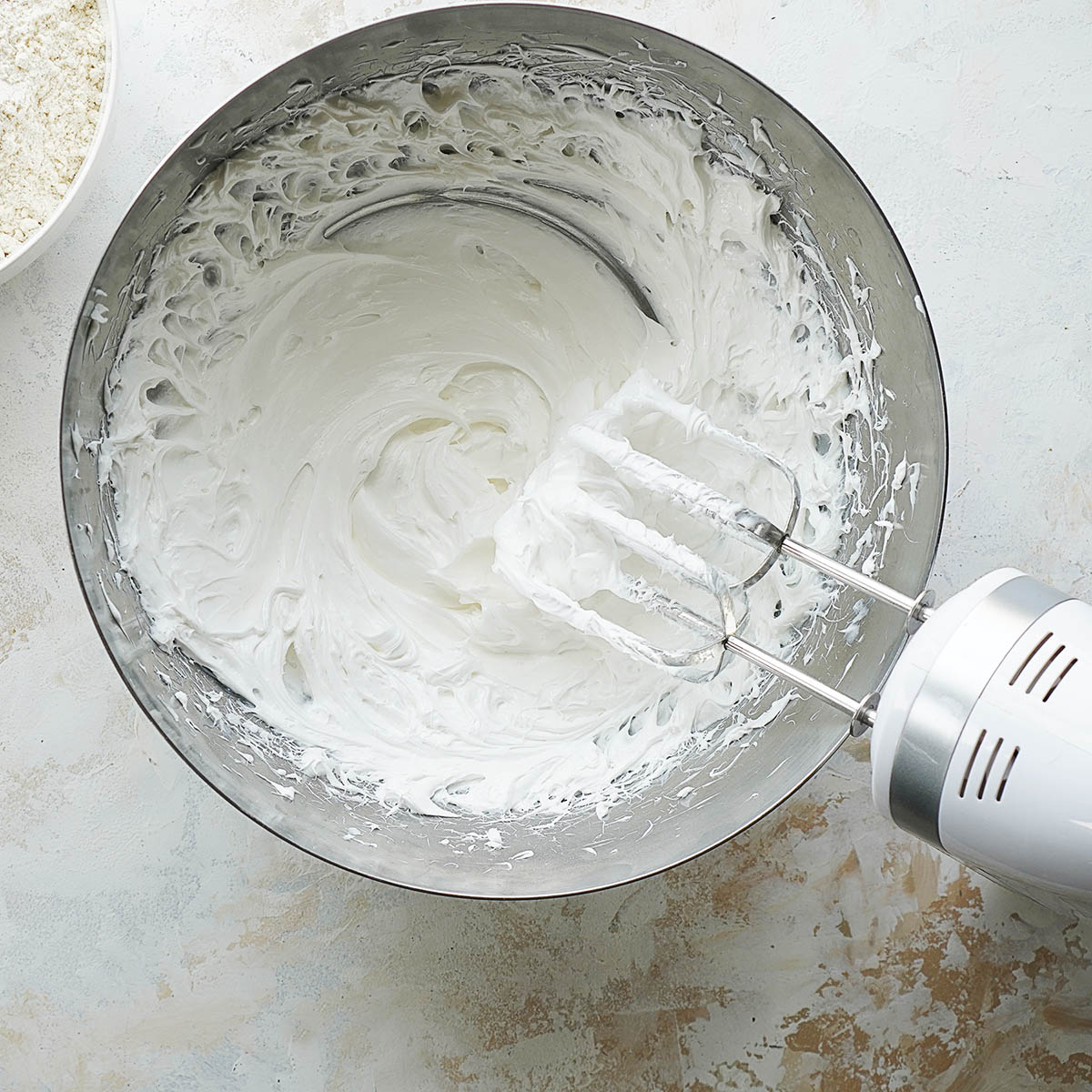
How do you know when the shortening is ready? The consistency will be lighter, fluffier and clearer.
Knead the masa harina:
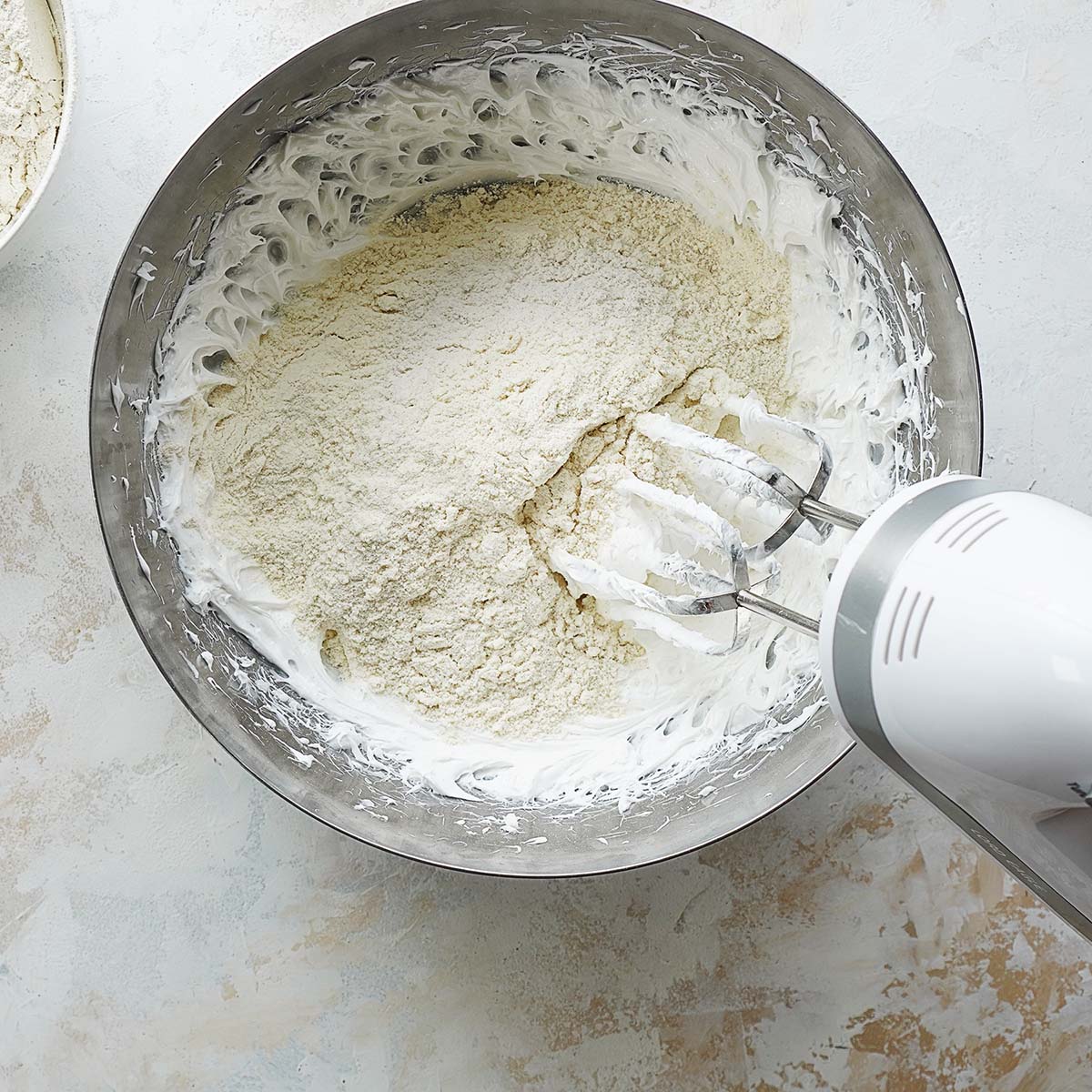
- When the shortening is ready, add the half of the masa harina, baking powder and salt. Knead/mix to integrate.
- When it’s crumbly add 1/3 of the broth and knead/mix until integrated.
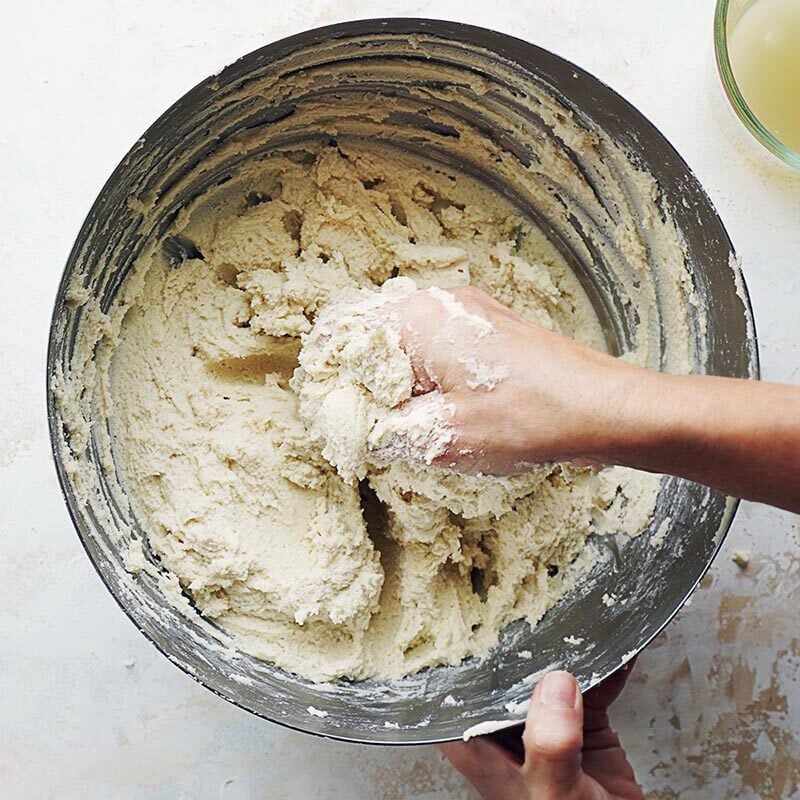
- Add the remaining masa harina and integrate.
- Lastly, add the remaining of the broth and knead for another 15 minutes by hand or 6 to 8 minutes at medium power in mixer. If using low speed, beat for 10 minutes or so.
Note: When using a hand mixer, I like to finish the last part of kneading by hand so that I don’t burn the mixer’s motor. At this point the masa is heavy and dense.
How do I know when the masa is ready?
The final result is a sticky dough. Also test by dropping 1/2 teaspoon of masa into a cup of very cold water. It if floats, it’s ready!
What happens if masa doesn’t float? Just keep kneading for another 5 minutes or until it pases the cold water test.
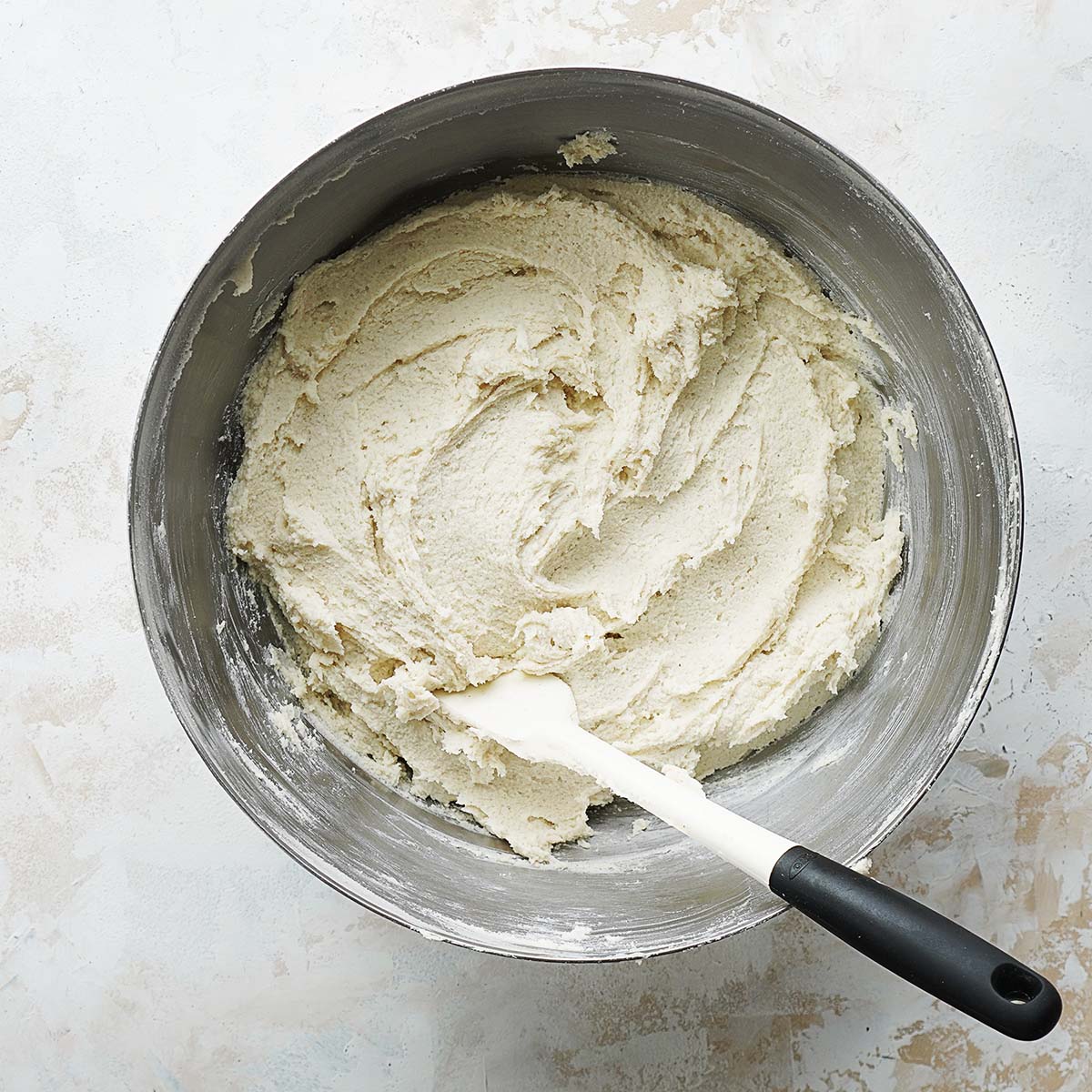
How to make vegetarian/vegan masa for tamales
Fortunately this recipe can easily be made into vegetarian/vegan masa! Use vegetable shortening and vegetable broth to make a delicious masa. The flavors don’t change much when you use these substitutes as the main flavor comes from the masa harina.
Then you can proceed to add your favorite vegetable fillings to make delicious vegetarian and vegan tamales!

How to Store
- Fridge: To store prepared masa, place in an airtight container or freezer bags in refrigerator for up to 3 days.
- Freezer: Place in a tightly closed container or freezer bags and for up to 6 months.
- Thaw in refrigerator before use.
The dry masa harina lasts between 8 and 10 months stored in a cool, dark place, such as the pantry, fridge or even in the freezer.
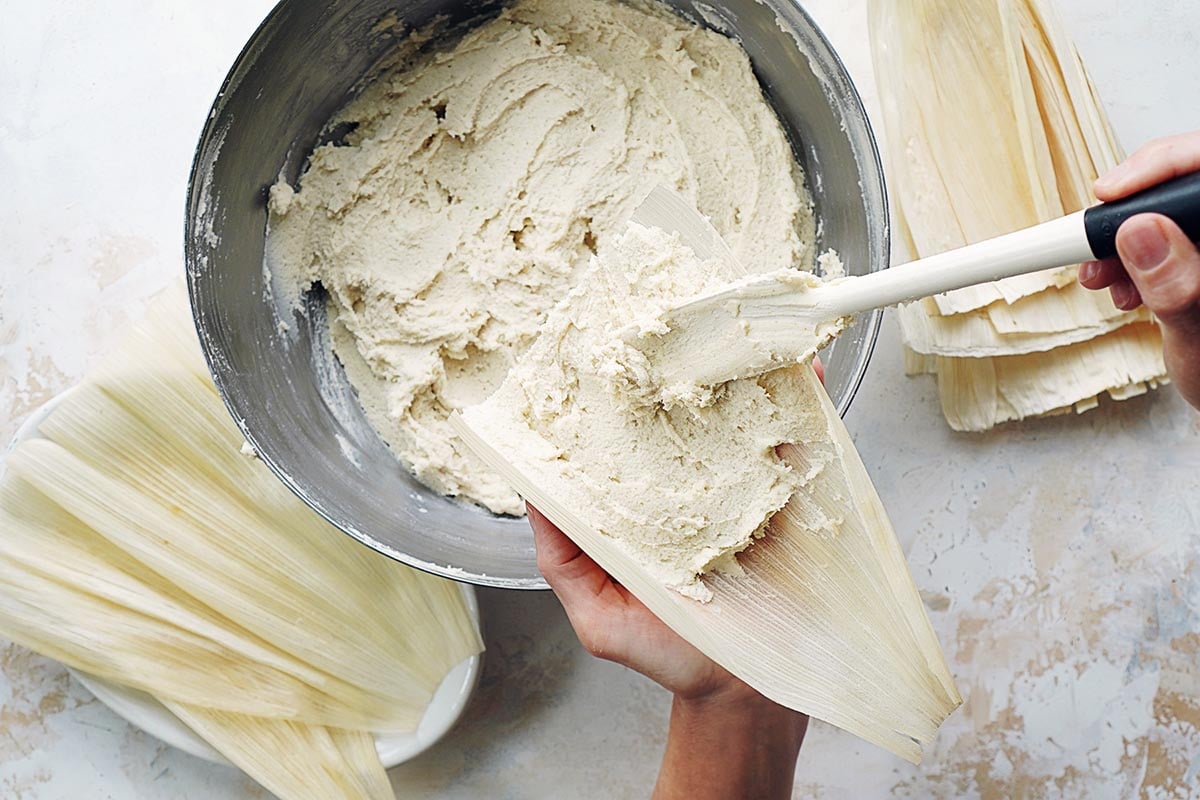
What is the difference between prepared and unprepared masa?
Prepared masa usually already has been mixed with lard or vegetable shortening, broth salt & baking powder. Just like recipe in this post.
Unprepared masa is usually just the ground corn in a solid form. Then you can add the ingredients to prepare it for the tamales. The unprepared masa can also be used to make sopes, corn tortillas and tlacoyos.
FAQs
Yes it’s the same masa. However, preparing the masa for tamales requires a little more work by adding the lard/shortening and broth. Masa for tortillas only requires masa harina, water and salt.
Yes you can! Make the masa beforehand and keep it refrigerated in a tightly closed container for up to 3 days or frozen for up to 6 months. Thaw in refrigerator before use.
Masa should be refrigerated if it won’t be cooking in a few hours. Do not leave it out overnight as it will spoil fast. Especially if it has been prepared with the broth!
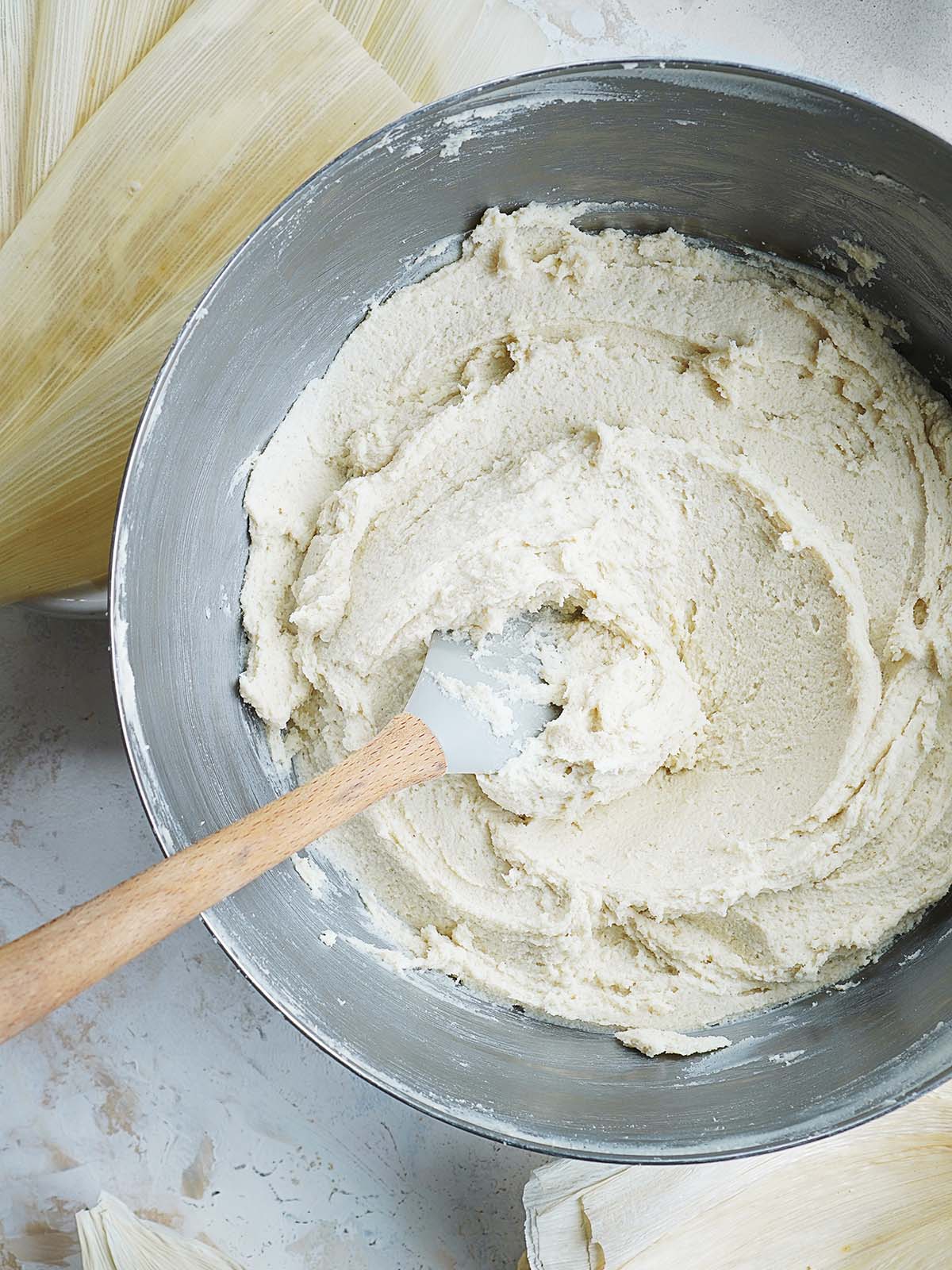

More Mexican Recipes
Thank you for stopping by!
I hope you like this recipe! Do you have any questions I can help you with? Or if you made it, I would love it if you leave a comment or rating below.
Gracias!!!! xx, Ana
Print Recipe:
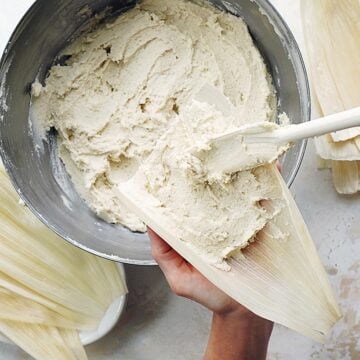
Traditional Masa For Tamales With Masa Harina
Equipment
- hand mixer or stand mixer – optional
Ingredients
- 3 cups + 2 Tablespoons Masa Harina (500g)
- 1 ½ cups vegetable shortening or lard (300g) at room temperature.
- 1 teaspoon baking powder
- ½ tablespoon table salt
- 3 cups broth (can be beef, chicken or vegetable), (750ml) at room temperature.
Instructions
Knead the shortening/lard:
- In a large bowl, add the shortening/lard and knead with your hands, a hand mixer or a stand mixer.
- If kneading by hand, knead about 15 to 20 minutes to reach the perfect consistency. If kneading with a mixer, beat for 5 minutes on medium speed.
Add he masa harina:
- When the shortening is ready, add the half of the masa harina, baking powder and salt. Knead/mix to integrate.
- When it's crumbly add ⅓ of the broth and knead/mix until integrated.
- Add the remaining masa harina and integrate.
- Add ⅓ broth and integrate. Then add the remaining of the broth and knead for another 15 minutes by hand or 6 to 8 minutes at medium powder in mixer.
Muy Delish Notes:
Add Your Own Private Notes
Whenever you come back to this recipe, you’ll be able to see your notes.
Nutrition
The nutritional information and US conversions are calculated automatically. I cannot guarantee the accuracy of this data. If this is important to you, please verify with your favourite nutrition calculator and/or unit conversion tool.


Making my masa with this recipe made my masa pass the cold water test on the first try for the very first time ever for me; it was beautiful, and the masa is wonderfully textured, spreads well, and tastes amazing. I used the broth from the pork I prepared for the tamales, and the flavor was off the hook!!! Thank you for the perfect masa recipe!!
This was very helpful! I made tamales a previous time and the masa never cooked/thickened when we steamed them. This was helpful tips! On my way to being good at making tamales for my family.
I can’t knead dough due to carpal. This makes it so easy to make masa for tamales with my stand mixer & comes out perfect every time! Thank you!
Like all of Ana’s recipes, this is an easy, tried and true recipe. Remember the 40/140/4 rule. If the product is left sitting between 40°F and 140°F for 4 hours or more, it could be spoiled so discard. Chicken, eggs, dairy and pork are especially sensitive so hold below or above these temperatures. Digital thermometers that use wired probes are very effective for monitoring. A simple 2 to 4 channel unit is very handy. Happy Holidays.
Used your recipe to make tamales for the first time. Recipe was easy to follow and the tamales were delicious. Not bad for my first time.
Que delicia !! Excelente receta para esta temporada !! Muchas gracias Ana !!
I’ll be honest, I love Mexican food, but I know very little about the ingredients and cooking methods. This post was incredibly informative, and truly inspired me to make Tamales from scratch. Masa Harina is on the way to get delivered tomorrow and I am beyond excited to put all I learned into practice!
How can I make tamales in a casserole-style with all the same authentic ingredients required in traditional tamales wrapped up in corn husks, but without the labor intensity tamales require?
Hi Sharyn, for best taste, add a layer of corn husk at the bottom of your casserole, then add a thick layer of masa then your filling. Lastly add another layer of thick masa and cover with corn husk. Cover with foil wrap and bake for about 45 minutes @375 or until cooked through. Check at that point to see if needs more time. Enjoy!
I’ve always wanted to try making homemade tamales, but I had no clue where to start. Your recipe is it! So helpful, especially about the dough floating in water. Can’t wait to make my own tamales!!
The tamale dough turns out incredibly light and fluffy, making each bite a pure delight. I can’t imagine making tamales without this amazing masa harina.
Loved this recipe and doing it from scratch! I appreciated the detailed instructions too, very helpful. Thank you!
I always wondered how masa was made! Can’t wait to try this recipe when I make tamales!!
Que ricos Ana!!!
Extremely informative & helpful. thank you!
Loved this recipe! Super detailed. I remember my mom & grandma making tamales when I was a little girl & this is the very closest recipe to how I watched them prepare & make tamales. Thank u!
Thanks so much for the feedback Marissa! I’m so happy you liked it. Feliz Navidad!
How many tamales will this make?
Hi Alexis, this will make about 40 tamales give or take. Enjoy!
Ana this masa turned out amazing! I used your red sauce to flavor it and the tamales turned out delicious! Thanks for the recipe!
I just made this and these instructions were the best I have found. Everyone loved them!
Who knows what 500g is in cups? I have no. Clue is that common to know that seriously
Hi Debbie, it is 3 cups + 2 tbsp. 🙂
The metric system should be standard when it comes to baking and cooking
There us nothing better than homemade tamales! This masa is spot on. Thanks for the recipe since I never know how much shortening to add. Happy holidays!